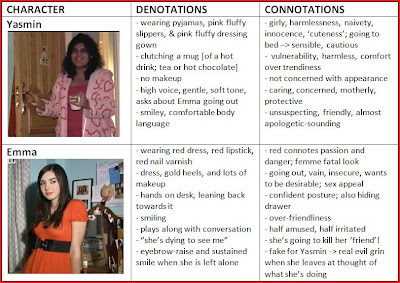Welcome to my Foundation Portfolio blog!! Thanks for taking the time to look at this one and my group blog too, and I hope you enjoy them as much as I enjoyed creating them :)
I have my group blog linked to my individual blog, and hopefully it'll be easy to navigate - on the blog list on the right you'll find links to:
- my group blog
- the blogs for the other members of my group
- our teacher's central blog, called BLK'S BLOG, which has links to all the student & group blogs
On my individual blog is all of my individual research, initial ideas, and planning, from the project's beginnings and mainly the early stages before we got into our groups. You'll also find my preliminary task work including the video, reflections on the project's development, and my responses to the evaluation questions.
My group blog has evidence of the planning and project development work as a group, and research that influenced and inspired our project that we did together.
I've linked my finished film opening sequence, Blink Murder, to both my individual blog and the group blog - it can be found at the top of the blog.
I've done my best to organise my blogs, so I hope you find it easy to navigate them :) All posts are organised in date order from November 2008, when we started the project, to February 2009 when we finished it. There are labels to identify all the research, planning, and evaluation work that I've completed on my individual blog. We've used the same system on the group blog, and I've also labelled the posts I was individually responsible for with my name.
I hope you like my blogs, and once again, enjoy!
Thank you! :)
Mia Obertelli 5610
 Similarly, the themes of revenge and extreme jealousy are also core to the plot of the film, and tend to be present in many films of the genre, such as Crush (Alison Maclean, 1992), where one character’s jealousy-provoked lies cause another to seek revenge on the object of the first’s jealousy. A more recent example is The Talented Mr Ripley (Anthony Minghella, 1999), which also explores the envy and instability of protagonist Tom Ripley, which causes him to turn into a murderer, just like Emma.
Similarly, the themes of revenge and extreme jealousy are also core to the plot of the film, and tend to be present in many films of the genre, such as Crush (Alison Maclean, 1992), where one character’s jealousy-provoked lies cause another to seek revenge on the object of the first’s jealousy. A more recent example is The Talented Mr Ripley (Anthony Minghella, 1999), which also explores the envy and instability of protagonist Tom Ripley, which causes him to turn into a murderer, just like Emma.








 Films such as the Saw (James Wan, 2004) series have such a strong branding and narrative image that they need very little information on posters – they can tell of a new film in the series, but without saying what will happen, acting as a teaser, enticing their fanbase to see the film even more.
Films such as the Saw (James Wan, 2004) series have such a strong branding and narrative image that they need very little information on posters – they can tell of a new film in the series, but without saying what will happen, acting as a teaser, enticing their fanbase to see the film even more.







 so that the one on top is more transparent, causing the effect as demonstrated to the right, and with the ECU shots of Emma's eyes at the beginning of the montage
so that the one on top is more transparent, causing the effect as demonstrated to the right, and with the ECU shots of Emma's eyes at the beginning of the montage










